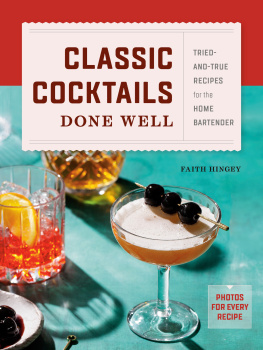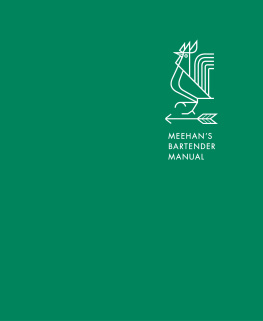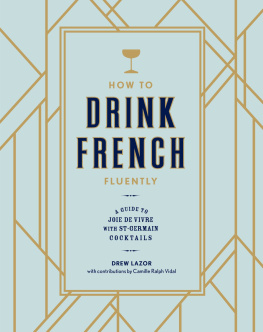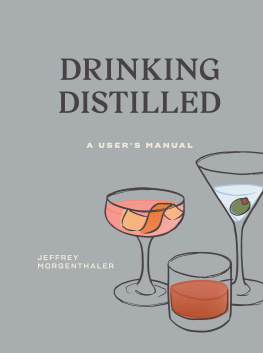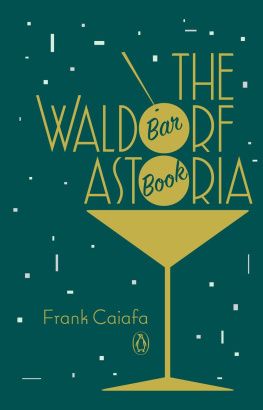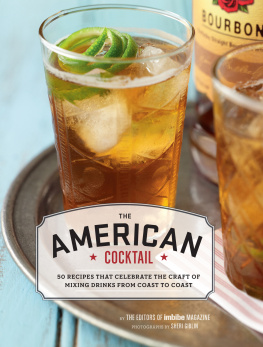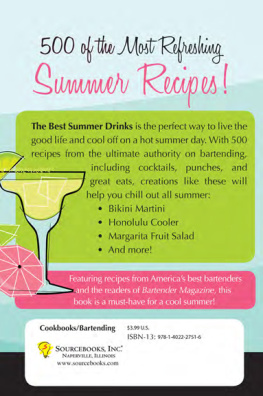
Text and illustrations copyright 2014 by Jeffrey Morgenthaler.
Photographs copyright 2014 by Alanna Hale.
All rights reserved. No part of this book may be reproduced in any form without written permission from the publisher.
ISBN 978-1-4521-3027-9 (epub, mobi)
Library of Congress Cataloging-in-Publication Data available.
ISBN 978-1-4521-1384-5 (hc)
Designed by Alice Chau
The photographer wishes to thank Arlo Jamrog and Helynn Ospina.
Chronicle Books LLC
680 Second Street
San Francisco, California 94107
www.chroniclebooks.com
This book is dedicated to the countless men and women all over the world whose bars I have sat at over the years, asking questions, borrowing ideas, and stealing recipes. It is your combined knowledge that fills these pages, and it is you who continually inspire me to work harder, learn more, and share with the rest of the world so that we can continue to keep growing this thing together.
CONTENTS
WHY I MAKE COCKTAILS, AND WHY I WROTE THIS BOOK
Ill never forget the first time I stepped behind the bar. It was the night of April 25, 1996, which was a Thursday. Id somehow convinced the manager to give me a job, though I had no experience and was about ten times cockier in the interview process than I was in real lifeor a hundred times more than I should have been, given my limited social skill set.
The place had been around since the repeal of Prohibition, with smoke-stained walls and Naugahyde booths. It was pretty rough-and-tumble, over in the sketchier part of town, opposite the university district, where I lived. I was nervous as hell, and my hands shook as I wrote down every order for the only drink we served there: one of three beers on tap. That night, and for pretty much every night the first summer I spent there, at least ten people told me I was the worst bartender theyd ever seen.
But I honestly didnt much care. I was at the University of Oregon, getting my degree in interior architecture, and bartending at night to make some money, meet some ladies, and have a little fun. Little did I know the job would grow on me, and that I would begin to grow on those people who thought I was the worst bartender ever.
It was just supposed to be a summer job, but when the fall quarter rolled around, the owners asked me to stay. And so I did. I worked at the Tiny Tavern in Eugene, Oregon, for four years while I went to school, and that time spent behind the bar there, serving the same three beers every night, laid the foundation for a life-long love affair with bars and bartending.
I started my first architecture job the summer after I graduated. It wasnt entirely full-time work, so I kept a few shifts behind the bar to pay the bills. It was fine, and I was happy to be finally working in the field I thought I wanted to be in, but over the course of several years I realized that Im not really the type to sit behind a desk.
I also realized something else, something far more important: bars, bartending, and cocktails were my hobby. I found myself coming home every night and reading up on classic cocktails. I spent my time at work online, bidding on out-of-print cocktail books, rare bar tools, and even rarer liquors. I had cocktail parties and regaled my friends with tales of the daiquiri, sidecar, and Manhattan while we sipped and swilled.
Eventually it became clear to me that my real interest lay in spending time behind the bar, and I slowly phased out the architecturemuch to the chagrin of my friends and family. I became involved in the world of restaurants, climbed higher and higher up the ladder of fine dining, and learned more and more every day about the craft of tending bar.
I started my own blog, mainly so our guests could have access to my cocktail recipes. I became more connected in the growing worldwide community of people interested in cocktails. People began to look to me for information, and at some point someone called me an expert.
Its all very surreal to think about. When Im not actively behind the bar, I spend my time managing, traveling, speaking at seminars and conferences, and training the next generation of bartenders. And these days, its only once a month that someone refers to me as the worst bartender theyve ever seen.
ANY GOOD COCKTAIL NEEDS THESE THREE ELEMENTS
When I train bartenders, I begin by teaching them one basic rule, and here it is: There are three things, of equal importance, that make a great cocktail. And unless all three are given their due respect, the drink you make isnt going to reach its full potential.
The first of these is the RECIPE that you choose. Lets say were going to make a whiskey sour in this example. Well, if you really start doing your research, youre going to find that there are about a thousand different recipes out there for a whiskey sour. Check the Internet if you dont believe me. One old book might tell you to begin with 1 oz/30 ml of whiskey and 2 oz/60 ml of sour mix, but some guys blog might argue that its gotta be 2 oz/60 ml of whiskey, with fresh lemon juice and a dollop of egg white. Another recipe might be too sweet, and yet another might not be sweet enough. Choosing the right recipe is exactly one-third of the battle.
The second thing thats going to make or break our whiskey sour is the INGREDIENTS we choose. Some whiskeys are better suited to the drink than others. A higher-proof bourbon whiskey is going to shine through the other ingredients better than a lower-proof Irish whiskey. If were using lemon juice, is it fresh or frozen? If were using egg whites, are they pasteurized and packaged or fresh from a local farm? All of these decisions are as important as the recipe weve spent years researching and perfecting.
But the third thing, the one thats so often overlooked by bartenders and home mixers, and the thing thats the subject of this book, is TECHNIQUE . Everything from juicing those lemons properly, preparing your egg whites, and measuring the ingredients to how the drink is shaken, strained, and served in a perfectly chilled glass is as important as the recipe and ingredients youve selected.
As you might guess, there are plenty of books out there about recipes. And there are more and more volumes on bookstore shelves every day about cocktail ingredients. But this book aims to be among the first in what will hopefully become an ongoing conversation about technique.
IVE ORGANIZED THE BOOK THE WAY I BUILD MY COCKTAILS
The chapters in this book are laid out a little differently than most other books. There is no chapter on vodkain fact there are no chapters on alcohol at all. Instead, we have broken down the cocktail-making process as you would do it behind the bar. The first third of the book is all about prep: well teach you how to get your juices ready, prepare your syrups, make your bitters, and produce your ice. Next well show you how to put the drink together: how to measure and properly mix. And then well show you how the drink is finished and served.
Ive included a few of my favorite recipes, which Ive collected over the yearsmy own, some of my friends, and some of the best versions of the classics Ive foundin order to illustrate some of the points were making about technique, and to show you how these techniques are applied.

CHAPTER NO
CITRUS JUICE
THE BRACING FOUNDATION OF A WIDE RANGE OF COCKTAILS
Next page

